- GCN/BACODINE POSITION NOTICE
TITLE: GCN/SWIFT NOTICE
NOTICE_DATE: Thu 22 Sep 05 19:58:36 UT
NOTICE_TYPE: Swift-BAT GRB Position
TRIGGER_NUM: 156467, Seg_Num: 0
GRB_RA: 317.391d {+21h 09m 34s} (J2000),
317.467d {+21h 09m 52s} (current),
316.720d {+21h 06m 53s} (1950)
GRB_DEC: -8.772d {-08d 46' 17"} (J2000),
-8.748d {-08d 44' 53"} (current),
-8.975d {-08d 58' 31"} (1950)
GRB_ERROR: 4.00 [arcmin radius, statistical only]
GRB_INTEN: 10866 [cnts] Image_Peak=1485 [image_cnts]
TRIGGER_DUR: 1.024 [sec]
TRIGGER_INDEX: 146 E_range: 25-100 keV
BKG_INTEN: 29968 [cnts]
BKG_TIME: 71736.00 SOD {19:55:36.00} UT
BKG_DUR: 8 [sec]
GRB_DATE: 13635 TJD; 265 DOY; 05/09/22
GRB_TIME: 71750.40 SOD {19:55:50.40} UT
GRB_PHI: 158.83 [deg]
GRB_THETA: 34.55 [deg]
SOLN_STATUS: 0x3
RATE_SIGNIF: 106.67 [sigma]
IMAGE_SIGNIF: 22.78 [sigma]
MERIT_PARAMS: +1 +0 +0 +1 +2 +25 +0 +0 +72 +1
SUN_POSTN: 179.91d {+11h 59m 39s} +0.04d {+00d 02' 18"}
SUN_DIST: 136.84 [deg]
MOON_POSTN: 58.59d {+03h 54m 21s} +24.28d {+24d 17' 05"}
MOON_DIST: 103.67 [deg]
MOON_ILLUM: 74 [%]
GAL_COORDS: 41.30,-34.62 [deg] galactic lon,lat of the burst (or transient)
ECL_COORDS: 317.16, 7.25 [deg] ecliptic lon,lat of the burst (or transient)
COMMENTS: SWIFT-BAT GRB Coordinates.
COMMENTS: This is a rate trigger.
COMMENTS: A point_source was found.
COMMENTS: This does not match any source in the on-board catalog.
COMMENTS: This does not match any source in the ground catalog.
COMMENTS: This is a GRB.
- red DSS finding chart
ps-file
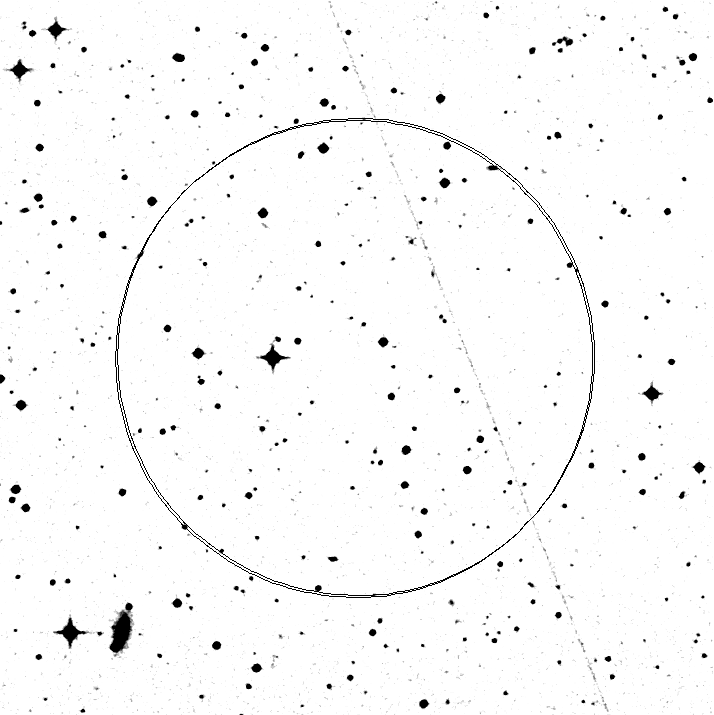
- GCN/BACODINE POSITION NOTICE
TITLE: GCN/SWIFT NOTICE
NOTICE_DATE: Thu 22 Sep 05 19:59:02 UT
NOTICE_TYPE: Swift-XRT Position
TRIGGER_NUM: 156467, Seg_Num: 0
GRB_RA: 317.3892d {+21h 09m 33.4s} (J2000),
317.4659d {+21h 09m 51.8s} (current),
316.7191d {+21h 06m 52.5s} (1950)
GRB_DEC: -8.7585d {-08d 45' 30.5"} (J2000),
-8.7350d {-08d 44' 06.0"} (current),
-8.9623d {-08d 57' 44.2"} (1950)
GRB_ERROR: 5.8 [arcsec radius, statistical plus systematic, 90% containment]
GRB_INTEN: 356.95 [arb]
GRB_SIGNIF: 6.16 [sigma]
GRB_DATE: 13635 TJD; 265 DOY; 05/09/22
GRB_TIME: 71858.06 SOD {19:57:38.06} UT [Start of CCD integration]
TAM[0-3]: 327.64 237.16 261.32 243.13
AMPLIFIER: 2
WAVEFORM: 134
SUN_POSTN: 179.91d {+11h 59m 39s} +0.04d {+00d 02' 16"}
SUN_DIST: 136.84 [deg]
MOON_POSTN: 58.60d {+03h 54m 25s} +24.29d {+24d 17' 21"}
MOON_DIST: 103.68 [deg]
MOON_ILLUM: 74 [%]
GAL_COORDS: 41.31,-34.61 [deg] galactic lon,lat of the burst
ECL_COORDS: 317.16, 7.26 [deg] ecliptic lon,lat of the burst
COMMENTS: SWIFT-XRT Coordinates.
COMMENTS: WARNING: XRT alignment calibration is on-going, and there may be
COMMENTS: residual systematic offsets of several arcseconds not accounted for yet
COMMENTS: by our on-board position determination algorithm. We have increased
COMMENTS: the estimated error circle radius to take this into account.
- GCN/SWIFT NOTICE
TITLE: GCN/SWIFT NOTICE
NOTICE_DATE: Thu 22 Sep 05 19:59:34 UT
NOTICE_TYPE: Swift-BAT GRB Lightcurve
TRIGGER_NUM: 156467, Seg_Num: 0
GRB_RA: 317.391d {+21h 09m 34s} (J2000),
317.467d {+21h 09m 52s} (current),
316.720d {+21h 06m 53s} (1950)
GRB_DEC: -8.772d {-08d 46' 17"} (J2000),
-8.748d {-08d 44' 53"} (current),
-8.975d {-08d 58' 31"} (1950)
GRB_DATE: 13635 TJD; 265 DOY; 05/09/22
GRB_TIME: 71750.40 SOD {19:55:50.40} UT
TRIGGER_INDEX: 146
GRB_PHI: 158.83 [deg]
GRB_THETA: 34.55 [deg]
DELTA_TIME: 25.00 [sec]
TRIGGER_DUR: 1.024 [sec]
LC_URL: sw00156467000msb.lc
SUN_POSTN: 179.91d {+11h 59m 39s} +0.04d {+00d 02' 18"}
SUN_DIST: 136.84 [deg]
MOON_POSTN: 58.59d {+03h 54m 21s} +24.28d {+24d 17' 05"}
MOON_DIST: 103.67 [deg]
MOON_ILLUM: 74 [%]
GAL_COORDS: 41.30,-34.62 [deg] galactic lon,lat of the pointing direction
ECL_COORDS: 317.16, 7.25 [deg] ecliptic lon,lat of the pointing direction
COMMENTS: SWIFT-BAT GRB Lightcurve.
COMMENTS:
COMMENTS: The next comments were copied from the BAT_POS Notice:
COMMENTS: This is a rate trigger.
COMMENTS: A point_source was found.
COMMENTS: This does not match any source in the on-board catalog.
COMMENTS: This does not match any source in the ground catalog.
COMMENTS: This is a GRB.
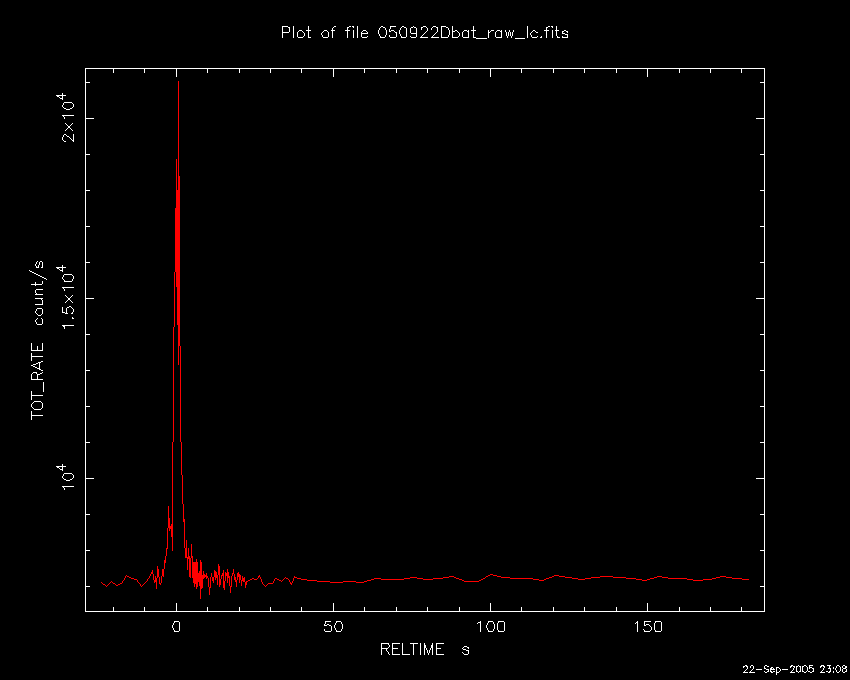
- GCN/SWIFT NOTICE
TITLE: GCN/SWIFT NOTICE
NOTICE_DATE: Thu 22 Sep 05 20:00:43 UT
NOTICE_TYPE: Swift-UVOT Source List
TRIGGER_NUM: 156467, Seg_Num: 0
POINT_RA: 317.343d {+21h 09m 22s} (J2000)
POINT_DEC: -8.774d {-08d 46' 25"} (J2000)
POINT_ROLL: 260.591d
GRB_DATE: 13635 TJD; 265 DOY; 05/09/22
GRB_TIME: 71861.56 SOD {19:57:41.56} UT
FILTER: 3, V
BKG_MEAN: 0.000000
N_STARS: 35
X_OFFSET: 518 [pixels]
Y_OFFSET: 642 [pixels]
X_MAX: 1477 [pixels]
Y_MAX: 1601 [pixels]
DET_THRESH: 6
PHOTO_THRESH: 2
SL_URL: sw00156467000msufc.fits
SUN_POSTN: 179.91d {+11h 59m 39s} +0.04d {+00d 02' 16"}
SUN_DIST: 136.79 [deg]
MOON_POSTN: 58.61d {+03h 54m 25s} +24.29d {+24d 17' 22"}
MOON_DIST: 103.73 [deg]
MOON_ILLUM: 74 [%]
GAL_COORDS: 41.27,-34.58 [deg] galactic lon,lat of the pointing direction
ECL_COORDS: 317.11, 7.26 [deg] ecliptic lon,lat of the pointing direction
COMMENTS: SWIFT-UVOT Source List.
- GCN/SWIFT NOTICE
TITLE: GCN/SWIFT NOTICE
NOTICE_DATE: Thu 22 Sep 05 20:01:37 UT
NOTICE_TYPE: Swift-UVOT Image
TRIGGER_NUM: 156467, Seg_Num: 0
POINT_RA: 317.343d {+21h 09m 22s} (J2000)
POINT_DEC: -8.774d {-08d 46' 25"} (J2000)
ROLL: 260.591d
GRB_DATE: 13635 TJD; 265 DOY; 05/09/22
GRB_TIME: 71861.56 SOD {19:57:41.56} UT
FILTER: 3, V
EXPOSURE_ID: 2275
X_OFFSET: 838 [pixels]
Y_OFFSET: 962 [pixels]
WIDTH: 160 [pixels]
HEIGHT: 160 [pixels]
X_GRB_POS: 998
Y_GRB_POS: 1122
BINNING_INDEX: 1
IM_URL: sw00156467000msuni.fits
SUN_POSTN: 179.91d {+11h 59m 39s} +0.04d {+00d 02' 16"}
SUN_DIST: 136.79 [deg]
MOON_POSTN: 58.61d {+03h 54m 25s} +24.29d {+24d 17' 22"}
MOON_DIST: 103.73 [deg]
MOON_ILLUM: 74 [%]
GAL_COORDS: 41.27,-34.58 [deg] galactic lon,lat of the pointing direction
ECL_COORDS: 317.11, 7.26 [deg] ecliptic lon,lat of the pointing direction
COMMENTS: SWIFT-UVOT Image.
COMMENTS: The GRB Position came from the XRT Position Command.
COMMENTS: The image has 2x2 binning (compression).
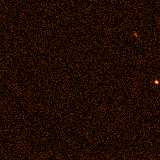
- GCN/SWIFT NOTICE
TITLE: GCN/SWIFT NOTICE
NOTICE_DATE: Thu 22 Sep 05 20:02:09 UT
NOTICE_TYPE: Swift-UVOT Processed Source List
TRIGGER_NUM: 156467, Seg_Num: 0
POINT_RA: 317.343d {+21h 09m 22s} (J2000)
POINT_DEC: -8.774d {-08d 46' 25"} (J2000)
POINT_ROLL: 260.591d
GRB_DATE: 13635 TJD; 265 DOY; 05/09/22
GRB_TIME: 71861.56 SOD {19:57:41.56} UT
FILTER: 3, V
BKG_MEAN: 0.000000
N_STARS: 35
X_OFFSET: 518 [pixels]
Y_OFFSET: 642 [pixels]
X_MAX: 1477 [pixels]
Y_MAX: 1601 [pixels]
DET_THRESH: 6
PHOTO_THRESH: 2
SL_URL: sw00156467000msufc.fits
SUN_POSTN: 179.91d {+11h 59m 39s} +0.04d {+00d 02' 16"}
SUN_DIST: 136.79 [deg]
MOON_POSTN: 58.61d {+03h 54m 25s} +24.29d {+24d 17' 22"}
MOON_DIST: 103.73 [deg]
MOON_ILLUM: 74 [%]
GAL_COORDS: 41.27,-34.58 [deg] galactic lon,lat of the pointing direction
ECL_COORDS: 317.11, 7.26 [deg] ecliptic lon,lat of the pointing direction
COMMENTS: SWIFT-UVOT Processed Source List.
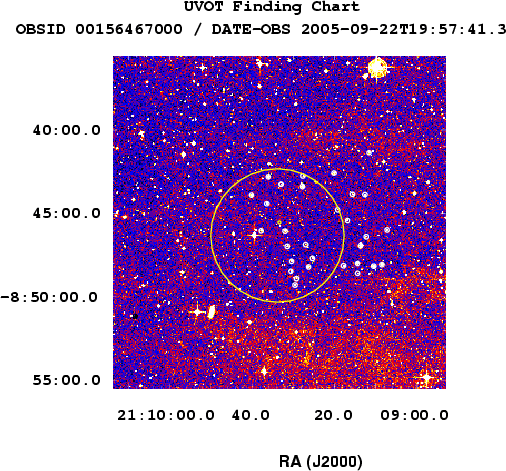
- GCN/SWIFT NOTICE
TITLE: GCN/SWIFT NOTICE
NOTICE_DATE: Thu 22 Sep 05 20:02:08 UT
NOTICE_TYPE: Swift-UVOT Processed Image
TRIGGER_NUM: 156467, Seg_Num: 0
POINT_RA: 317.343d {+21h 09m 22s} (J2000)
POINT_DEC: -8.774d {-08d 46' 25"} (J2000)
ROLL: 260.591d
GRB_DATE: 13635 TJD; 265 DOY; 05/09/22
GRB_TIME: 71861.56 SOD {19:57:41.56} UT
FILTER: 3, V
EXPOSURE_ID: 2275
X_OFFSET: 838 [pixels]
Y_OFFSET: 962 [pixels]
WIDTH: 160 [pixels]
HEIGHT: 160 [pixels]
X_GRB_POS: 998
Y_GRB_POS: 1122
BINNING_INDEX: 1
IM_URL: sw00156467000msuni.fits
SUN_POSTN: 179.91d {+11h 59m 39s} +0.04d {+00d 02' 16"}
SUN_DIST: 136.79 [deg]
MOON_POSTN: 58.61d {+03h 54m 25s} +24.29d {+24d 17' 22"}
MOON_DIST: 103.73 [deg]
MOON_ILLUM: 74 [%]
GAL_COORDS: 41.27,-34.58 [deg] galactic lon,lat of the pointing direction
ECL_COORDS: 317.11, 7.26 [deg] ecliptic lon,lat of the pointing direction
COMMENTS: SWIFT-UVOT Processed Image.
COMMENTS: If you have elected to receive attachments:
COMMENTS: The uvot_catalog_image.fits file does not exist; skipping the attachment.
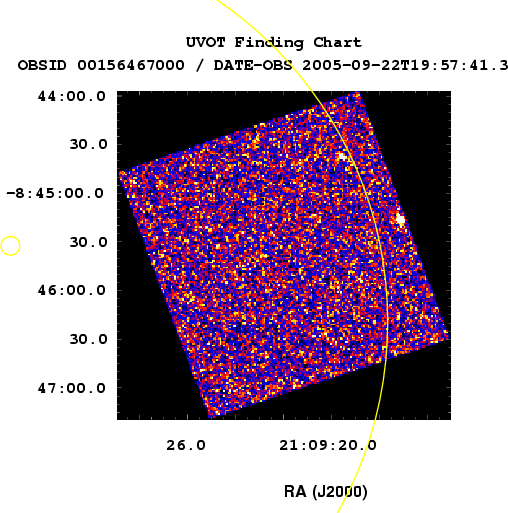
- GCN notice #4011
E.S. Rykoff (U Mich), S.A. Yost (U Mich), W. Rujopakarn (U Mich) report
on behalf of the ROTSE collaboration:
ROTSE-IIId, located at the Turkish National Observatory at Bakirlitepe,
Turkey, responded to GRB 050922A (Swift trigger 156467). The first image
was at 19:58:42.8 UT, 172.4 s after the burst (6.8 s after the GCN
notice time). The unfiltered images are calibrated relative to USNO
A2.0. We detect a new object, not visible in the DSS (second epoch),
with coordinates:
21:09:33.1 -08:45:29.8 (J2000)
start UT mag mlim(of image)
----------------------------------
19:58:42.8 14.7 16.1
Continuing observations are in progress.
- GCN notice #4012
E.S. Rykoff (U Mich), S.A. Yost (U Mich), W. Rujopakarn (U Mich), R.
Quimby (U Texas), D. A. Smith (Guilford), F. Yuan (U Mich) report
on behalf of the ROTSE collaboration:
ROTSE-IIId, located at the Turkish National Observatory at Bakirlitepe,
Turkey, responded to GRB 050922C (Swift trigger 156467). (Note that the
burst designation in GCN 4011 is incorrect).
We obtained 10 5-s images followed by 12 20-s images before
precipitation ended observations. The object reported in GCN 4011 fades
significantly from 172 s post-burst to 651 s post-burst as a simple
power-law with index -1.0. At 640 s post-burst the counterpart was at
16.0+/-0.1 mag (unfiltered) relative to the USNO A2.0 R-band magnitudes.
A finding chart can be found at:
http://www.rotse.net/grb_reports/050922C_btab.html
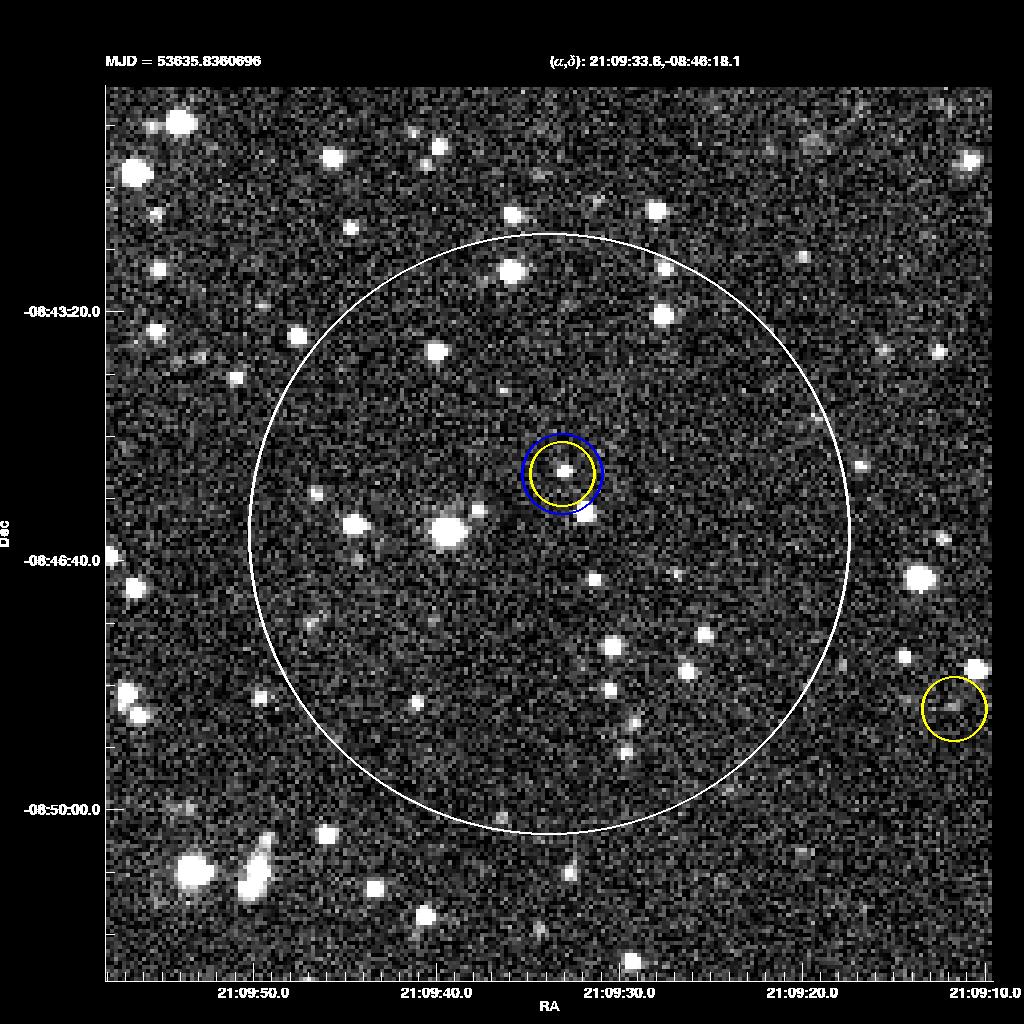
- GCN notice #4013
J. Norris (GSFC), L. Barbier (GSFC), D. Burrows (PSU), A. Cucchiara (PSU),
J. Cummings (GSFC/NRC), N. Gehrels (GSFC), M. Goad (U. Leicester),
O. Godet (U. Leicester), S.T. Holland (GSFC/USRA), J. Kennea (PSU),
F. Marshall (GSFC), D. Palmer (LANL), T. Sakamoto (GSFC/NRC),
on behalf of the Swift team:
At 19:55:50 UT Swift-BAT triggered and located GRB 050922C (Trigger=156467)
and immediately slewed. The BAT on-board calculated position is RA,Dec=
317.391d, -8.772d {21h 09m 34s, -08d 46' 17"} (J2000) with an uncertainty
of 3 arcmin (radius, 90% containment, stat+sys). The TDRSS light curve
shows an intense GRB with a rising precursor starting at T-5 seconds,
followed by 5-second long main peak surmounted by three spikes. The third
and most intense spike has a maximum count rate at T+1 sec of 15,000
counts/sec (15-350 keV).
XRT began observing the field at 19:57:38 UT, 108 seconds after the BAT
trigger. XRT performed an onboard centroid and found a previously
uncataloged fading source in the field of view at the following coordinates:
RA(J2000): 21:09:33.4,
Dec(J2000): -8:45:30.5,
with an estimated uncertainty of 8 arcseconds radius (90% containment). This
position is 49 arcseconds from the BAT position and within 4.5 arcsec of the
optical transient reported by Rykoff et al. (GCN circ 4011 [mistitled]).
UVOT began observing at 111 sec after the trigger. The small UVOT TDRSS
image does not overlap the XRT error circle. However, the full-field UVOT
source list contains a bright, uncataloged source within the XRT error
circle. We estimate the V magnitude at 15.5 +- 0.5 uncorrected for
extinction. The V-band extinction in this field is A_V = 0.34 mag.
- GCN notice #4015
Pall Jakobsson (DARK, NBI), Danka Paraficz, John Telting
(NOT, La Palma), Johan P. U. Fynbo, Brian L. Jensen,
Jens Hjorth and Jose Maria Castro Ceron (DARK, NBI) report:
Using ALFOSC on the 2.56-meter Nordic Optical Telescope,
we have obtained a 300 s R-band image of the GRB 050922C
field (Swift trigger: 156467, GCN#4013 (Norris et al.)).
Using a preliminary photometric zeropoint we estimate the
following magnitude for the afterglow:
R ~ 16.5 @ 1 hour post-burst.
The coordinates are:
(RA, Dec)(J2000.0) = (21:09:33.083, -08:45:30.2)
with a 0.2" error in each coordiante.
A finding chart of the field is available at:
http://www.astro.ku.dk/~brian_j/grb/grb050922.830/
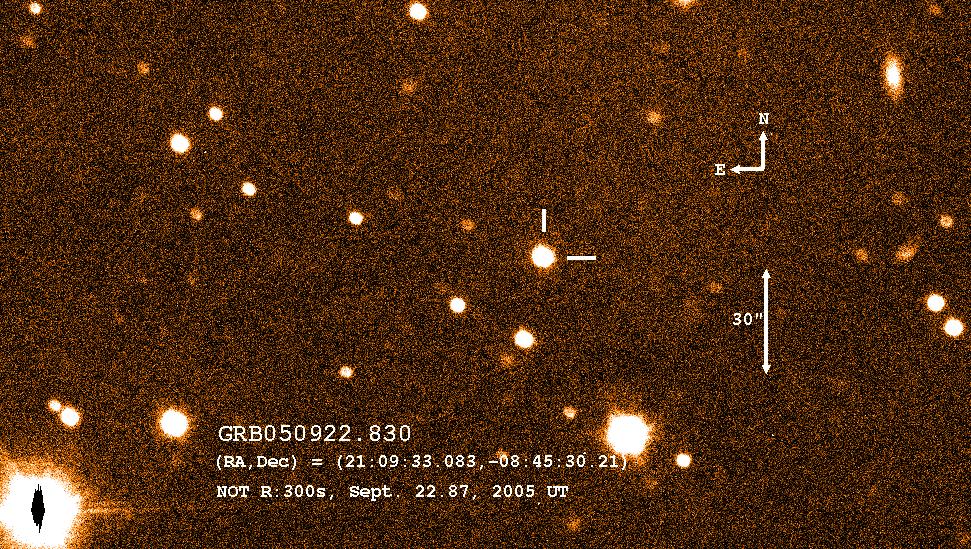
- GCN notice #4016
M. Andreev, A. Pozanenko on behalf of larger GRB follow up collaboration
report:
We observed the GRB 050922C field (Swift trigger: 156467, GCN4013 Norris et
al.) in R-band with 60 cm telescope of Terskol observatory. We confirm the
new OT found in by ROTSE-IIId (GCNs 4011, 4012, Rykoff et al.) OT is fading
and
preliminary photometry of the OT against of USNO A2.0 of the first image
taken at (UT) 20:08:45 is R~16.
The observation is continuing.
- GCN notice #4017
Pall Jakobsson, Johan P. U. Fynbo, (DARK, NBI), Danka Paraficz,
John Telting (NOT, La Palma), Brian L. Jensen, Jens Hjorth and
Jose Maria Castro Ceron (DARK, NBI) report:
Using ALFOSC on the Nordic Optical Telescope (NOT) we have obtained
spectra of the afterglow of GRB 050922C (GCN#4013 Norris et al.
[Swift], GCN#4012 Rykoff et al. [ROTSE-III], GCN#4015
Jakobsson et al. [NOT]) on 2005, Sep 22.9 UT.
We find several absorption features, including strong Lyman-alpha,
OI+SiII, CII, SiIV, CIV, AlII and AlIII, corresponding to a redshift
of z = 2.17+-0.03 (based on a preliminary wavelength calibration).
There is additional strong absorption, possibly corresponding to
Lyman-alpha at z = 2.05+-0.03.
- GCN notice #4018
E. O. Ofek, Y. M., Lipkin, J. Dann (Wise observatory, TAU) report:
We have observed the Swift error box of GRB050922C
(Norris et al. GCN 4013) using the Wise observatory 1m
telescope starting at 2005, Sep 22nd, 22:10:56 UTC.
We obtained a 210 sec unfiltered image (mid exposure
time 0.0950 days after the Swift-BAT trigger) in which
we detected the optical transient (OT) discovered by
Rykoff et al. (GCN 4011).
At that epoch, the OT magnitude was R~17.9, assuming
R-mag=14.24 for the bright star 37 arcsec at PA=210deg
from the OT.
- GCN notice #4020
H. Krimm (GSFC/USRA), L. Barbier (GSFC), S. Barthelmy (GSFC),
J. Cannizzo (GSFC-UMBC), L. Cominsky (Sonoma State U.),
J. Cummings (GSFC/NRC), E. Fenimore (LANL), N. Gehrels (GSFC),
D. Hullinger (UMD), C. Markwardt (GSFC/UMD), D. Palmer (LANL),
A. Parsons (GSFC), T. Sakamoto (GSFC/NRC), G. Sato (ISAS),
J. Tueller (GSFC) on behalf of the Swift-BAT team:
Using the data set from T-10 to T+60 sec from the recent telemetry
downlink, we report further analysis of Swift-BAT GRB 050922C
(trigger #156467) (Norris, et al., GCN 4013). The refined BAT ground position
is (RA,Dec) = 317.381, -8.762 {21:09:32, -8:45:43} [deg; J2000]
+- 1.0 arcmin, (radius, sys+stat, 90% containment). The partial coding
was 53%.
The light curve shows the intense broad peak starting from T-3 to T+3 with
at least two sub-peaks on top. T90 (15-350 keV) is (5 +- 1) sec
(estimated error including systematics).
The power law index of the time-averaged spectrum is 1.33 +- 0.06.
The fluence in the 15-150 keV band is (1.7 +- 0.1) x 10^-6 erg/cm2.
The 1-sec peak photon flux measured from T-0.02 sec in the 15-150 keV
band is (7.5 +- 0.3) ph/cm2/sec. All the quoted errors are at the 90%
confidence level.
- GCN notice #4021
HETE Fregate observations of GRB 050922C
G. Crew, G. Ricker, J-L. Atteia, N. Kawai, D. Lamb, and S. Woosley, on
behalf of the HETE Science Team;
M. Arimoto, T. Donaghy, E. Fenimore, M. Galassi, C. Graziani,
J. Kotoku, M. Maetou, M. Matsuoka, Y. Nakagawa, T. Sakamoto, R. Sato,
Y. Shirasaki, M. Suzuki, T. Tamagawa, K. Tanaka, Y. Yamamoto,
and A. Yoshida, on behalf of the HETE WXM Team;
N. Butler, J. Doty, G. Prigozhin, R. Vanderspek, J. Villasenor,
J. G. Jernigan, A. Levine, G. Azzibrouck, J. Braga, R. Manchanda,
and G. Pizzichini, on behalf of the HETE Operations and HETE
Optical-SXC Teams;
M. Boer, J-F Olive, J-P Dezalay, and K. Hurley, on behalf of the HETE
FREGATE Team;
report:
The HETE Fregate instrument detected GRB 050922C (Swift trigger 156647;
Norris et al, GCN 4013). The flight instruments did not trigger because
they were processing another trigger (H3934) which occurred 204 seconds
earlier.
The burst was clearly detected in Fregate in the 7-30, 7-80, and 30-400
keV bands. The burst spectrum is best fit with a cutoff power law of
photon index 0.83 (-0.26/+0.23) and Epeak of 130.5 keV (-26.8/50.9). The
2-30 keV fluence is 5.4e-7 erg/cm2; the 30-400 keV fluence is 2.6e-6 erg/cm2.
The ratio of the 2-30 keV to 30-400 keV fluence is 0.2: thus, GRB 050922C
is a classical GRB.
Due to the hardness of the spectrum, we have not been able to determine
the high-energy slope (beta) of the Band function for this burst. The
determination of bolometric fluence is therefore subject to systematic
uncertainty. Assuming z=2.17 (Jakobbson et al., GCN 4017) and assuming
the above cutoff power-law applies in the source-frame energy range of
1-10000 keV, the lower bound on E_iso is E_iso=3.7E+52 erg. The upper
bound, obtained assuming beta=-2.0, is E_iso=7.0E+52 erg.
- GCN notice #4022
J. A. Kennea, D. N. Burrows (PSU), M. Goad (U. Leicester), J. Norris and
N. Gehrels (GSFC) report on behalf of the Swift/XRT Team:
We report on detailed ground analysis of the first 2 orbits of data from
X-ray afterglow of GRB050922C (GCN 4013) utilizing downlinked Swift/XRT
data. We find a refined position for the XRT afterglow of:
RA(J2000): 21:09:33.3,
Dec(J2000): -8:45:27.5,
with an estimated uncertainty of 6 arcseconds radius (90% containment).
We note
that this position is 4.6 arcseconds from the NOT optical afterglow position
reported in GCN 4015.
We have extracted a lightcurve of combined Window Timing and Photon
Counting mode data from the first two orbits of XRT observations, covering
6500ks of time. The lightcurve of the afterglow is well described by a
single powerlaw model with a slope of -1.14 +/- 0.02.
The spectrum of the afterglow is well fit (reduced Chi^2 = 0.94 with 44 dof)
by an absorbed power-law model with the following parameters:
N_H = (6.5 +/- 2.7) x 10^20 cm^-2
Photon Index = 1.89 +/- 0.16
The absorption seen here is consistant with the expected Galactic absorption of
5.75 x 10^20 cm^-2. Utilizing this spectral model, we estimate the flux of this
burst (corrected for absorption) to be:
BAT Trigger +1 hour: 1.5 x 10^-11 erg/s/cm^2 (0.5 - 10 keV)
BAT Trigger +1 day: 3.9 x 10^-13 erg/s/cm^2 (0.5 - 10 keV)
Note that the latter flux estimate assumes that the lightcurve does not
break.
Observations of this burst by Swift are on-going.
- GCN notice #4023
D. T. Durig (Cordell-Lorenz Observatory - University of the South) and A.
Price (AAVSO) report on behalf of the AAVSO International High Energy
network on optical observations of GRB050922C.
After glow reported by Rykoff et al (GCN #4011) was visible in 2 hours of
exposures. The first three measurements are below and a link to the rest
is in the full report at the bottom of the e-mail. Uncertainty is
estimated at +/-0.2 mag.
09 23.03833 19.1 Rc
09 23.07725 19.5 Rc
09 23.10989 20.1 Rc
The AAVSO would like to thank the Curry Foundation and NASA for their
support of the AAVSO International High Energy Network.
Name: Dr. Douglas T. Durig
email: ddurig@sewanee.edu
Observer: D. T. Durig, K. T. Crockett, L. R. Johnson
Site: Cordell-Lorenz Observatory
Location: Sewanee, TN, USA
LatitudeLongitude: 35 12 N 85 55 W
Elevation: 600 m
Scope: SCT 0.30 m
ScopeFocalRatio: f/5.9 1770 mm
CCDVendor: SBIG ST-8E
CCDDetector: KAF-1600E
CCDSize: 1530x1020 binned 3x3 for 510x340
CCDPixelScale: 3.14 arc sec per pixel
CCDFOV: 26.7x17.8 full, 13.3x8.9 cropped submitted
Object: GRB050922C
ObsDate: 2005 09 23
ObsMidPointTime: 01:51:14 UT
TimePerFrame: 300 sec
NumberOfFrames: best 24 out of 30
Filters: CR
Processing: dark,flat, register,co-add, 1/2 frame crop
Seeing: 5-6 arc sec
LimitingMag: ~21.5 ???
Sky: clear, but very gusty winds
afterglowmag: 19 fading to 20 over two hours time
afterglowerr: 0.2 mag
compstars: 94 UCAC, 188 B1.0 subframe
Report: Full frame covers entire error box. After glow reported by Rykoff et al (GCN 4011) was visible in single 300 sec exposure but 6 frames were added to improved S/N for measurements. We measure a position of
21 09 33.10 -08 45 30.2
First three photometric measurements shown below.
We have posted our first 2 hours of exposure at
http://arthur.sewanee.edu/obsv/view.php
comments: 09 23.03833 21 09 33.10 -08 45 30.2 19.1 R
09 23.07725 21 09 33.12 -08 45 30.4 19.5 R
09 23.10989 21 09 33.12 -08 45 30.7 20.1 R
A FITS image has been uploaded to
ftp://ftp.aavso.org/grb/Dr.DouglasT.Durig_GRB050922C_2453636.66853_.fits
- GCN notice #4026
T. Henych, M. Kocka, F. Hroch (MU Brno, Czech Republic),
Martin Jelinek (IAA Granada, Spain) and
Rene Hudec (ASU AV CR Ondrejov, Czech Republic)
report:
We have observed the optical transient of GRB050922C reported
by Rykoff et al. (GCN 4011) for 1.2h with the mean time 0.100d
after the GRB trigger (Norris et al., GCN 4013) with the 60cm
telescope at MonteBoo Observatory equipped with an ST8 CCD. We
have found the OT at roughly R=18 decaying with an index
\alpha = -0.5 .
This message may be cited.
- GCN notice #4027
R. Novak (N. Copernicus Observatory in Brno, Czech Republic),
report:
We have observed the optical transient of GRB050922C reported
by Rykoff et al. (GCN 4011) for 2h with the mean time 0.1d
after the GRB trigger (Norris et al., GCN 4013) with the 40cm
telescope at N. Copernicus Observatory equipped with an ST7 CCD (with
R band filter). We have found the OT as very faint object close to 18
mag. More data reductions will follow.
This message may be cited.
- GCN notice #4029
P=E1ll Jakobsson, Johan P. U. Fynbo, (DARK, NBI), Danka Paraficz,
John Telting (NOT, La Palma), Brian L. Jensen, Jens Hjorth and
Jos=E9 Mar=EDa Castro Cer=F3n (DARK, NBI) report:
Using new wavelength calibration files, we have refined the
GRB 050922C redshift obtained at the NOT (GCN 4017). Based on the
detection of Lyman-alpha, OI+SiII, CII, SiIV, FeII, AlII, SiII* and
SiII in absorption, we measure a redshift of z = 2.198+-0.001.
There is additional strong absorption, possibly corresponding to
Lyman-alpha at z =3D 2.07.
- GCN notice #4030
S. Golenetskii, R.Aptekar, E. Mazets, V. Pal'shin, D. Frederiks, and
T. Cline on behalf of the Konus-Wind team report:
The GRB 050922C (Swift-BAT trigger #156467;
Norris et al., GCN 4013, Krimm et al., GCN 4020)
triggered Konus-Wind at T0=71754.480 s UT (19:55:54.480).
As observed by Konus-Wind it had a duration of ~5 s,
fluence (7.3 +/- 0.5)10-6 erg/cm2,
peak flux on 128-ms time scale (4.5 +/- 0.7)10-6 erg/cm2/s
(both in the 20 keV - 2 MeV energy range).
The time-integrated spectrum of the GRB
(from T0 to T0+8.448 s) is well fitted (in the 20 keV - 2 MeV range)
by a power law model with photon index 1.55 +/- 0.07.
The spectrum does not demonstrate an exponential cutoff
with E0 ~100 keV reported by HETE Fregate (Crew et al., GCN 4021).
Assuming z = 2.17 (Jakobsson et al., GCN 4017) and a standard cosmology
model with H_0 = 70 km/s/Mpc, Omega_M = 0.3, Omega_\Lambda = 0.7,
the isotropic energy release is E_iso ~8.1x10^52 erg,
the maximum luminosity is (L_iso)_max ~1.6x10^53 erg/s.
- GCN notice #4032
S. Piranomonte (INAF/OAR), A. Magazzu (TNG), G. Mainella (TNG),
F. Fiore (INAF/OAR), S. Covino (INAF/OABr), D. Fugazza (INAF/OABr),
A. Antonelli (INAF/OAR), G. Israel (INAF/OAR), G. Chincarini
(Univ. Milano-Bicocca), D. Malesani (SISSA), , F. Mannucci (INAF/Arcetri),
G. Tagliaferri (INAF/OABr), and L. Stella (INAF/OAR) on behalf of the
CIBO collaboration, report:
Starting on September 22 21:17:35 UT (about 82 min after the GRB
trigger) we have obtained low resolution spectra
of the optical afterglow of GRB050922C (Rykoff et al.
GCN#4012). The observations consisted of 5 exposures for 300 sec each with
DOLORES@TNG, using grism LR-B, with a 1" slit. This set-up provides
a resolution of about 5 angstrom.
At the time of the observations the afterglow magnitude varied between
R~16.7 and R=17.7.
A preliminary analysis of the data confirms a very rich spectrum
(see Jakobsson et al. GCN#4017, GCN#4029).
We detect strong Lyalpha, SiII1304, CII1334, SiIV1393, SiII1526,
CIV1548,1550, AlII1670, SiII1808 absorption lines at z=2.198+/-0.001,
We also confirm the strong Lyalpha absorption at z=2.07.
A full analysis is underway.
We thank the TNG staff for the excellent support in performing these
observations.
This message can be quoted.
- GCN notice #4040
Johan P. U. Fynbo, Brian L. Jensen, P=E1ll Jakobsson,
Jens Hjorth, Jesper Sollerman, Jos=E9 Mar=EDa Castro Cer=F3n
(DARK, NBI), Karianne Holhjem (NOT, La Palma), Ricardo Salinas
(Universidad de Concepci=F3n, Chile) report:
We have obtained further imaging of the afterglow of GRB 050922C
(GCN 4011, 4012, 4013) using the ALFOSC at the Nordic Optical
Telescope on La Palma and DFOSC at the Danish 1.5m telescope at La
Silla, Chile. We find that the early decay slope of about 1 (GCN 4012)
extends to less than a day post burst, after which the decay slope
steepens to about alpha=3D1.7+-0.3. Further observations are planned.
A preliminary lightcurve can be seen at:
http://www.astro.ku.dk/~brian_j/grb/grb050922.830/
- GCN notice #4041
S. D. Hunsberger (PSU), F. Marshall (GSFC), S. T. Holland (GSFC),
P. Brown (PSU), A. Morgan (PSU), P. Roming (PSU), and
A. Cucchiara (PSU) on behalf of the Swift/UVOT teams
The UVOT began observing GRB050922C at 19:57:41UT, 111 seconds
after the BAT trigger (Norris et al., GCN 4013). A fading
optical counterpart is detected at 21:09:33.0 -08:45:30.1. The
afterglow is apparent in the UBV filters and there is a marginal
detection in UVW1 which is likely due to the redward edge of the
filter response overlapping the U bandpass. The UVOT magnitudes
listed below are not corrected for extinction. Tmid is the time
since trigger of the midpoint of the exposure(s).
Filter Tmid(s) Exp(s) Mag
V 115.5 99.8 14.60 +- 0.10
V 374.5 9.8 15.49 +- 0.17
V 543.5 9.8 15.99 +- 0.21
V 712.5 9.8 16.01 +- 0.21
V 4543.5 899.8 17.62 +- 0.11
V 15962.5 899.8 18.89 +- 0.21
V 28443.5 899.8 19.95 is 3sigma upper limit
B 261.5 9.8 15.88 +- 0.13
B 430.5 9.8 16.36 +- 0.15
B 598.5 9.8 16.45 +- 0.16
B 767.0 8.4 16.91 +- 0.20
B 11133.5 899.8 19.12 +- 0.11
B 22648.5 899.8 20.13 +- 0.21
B 39108.5 897.3 20.70 +- 0.38
B 50681.5 899.8 20.74 +- 0.39
U 246.5 9.8 15.09 +- 0.19
U 416.5 9.7 15.69 +- 0.20
U 584.5 9.8 15.84 +- 0.21
U 753.5 9.7 16.00 +- 0.21
U 10226.5 899.8 18.58 +- 0.18
U 21749.0 900.0 19.13 +- 0.20
U 34939.5 507.6 19.88 +- 0.31
U 46660.0 814.1 19.89 +- 0.26
UVW1 487.0 68.6 17.70 +- 0.29 (co-added 10s exposures)
UVW1 6233.5 651.1 19.96 +- 0.41
UVW1 17730.0 806.0 20.18 is 3sigma upper limit
UVM2 473.0 68.5 18.86 is 3sigma upper limit (co-added)
UVM2 5450.5 899.8 20.48 is 3sigma upper limit
UVW2 487.5 58.8 19.30 is 3sigma upper limit (co-added)
UVW2 11969.5 753.2 20.62 is 3sigma upper limit
Magnitudes are based on preliminary zeropoints, measured in orbit, and
may require further refinement.
- GCN notice #4044
V. D'Elia, S. Piranomonte, F. Fiore (INAF-OAR), S. Covino (INAF/OABr),
L.A. Antonelli, G.L. Israel,
L. Stella, L. Sbordone (INAF-OAR), D. Fugazza, G. Tagliaferri
(INAF/OABr), D. Malesani (SISSA), G. Chincarini (Univ. Milano-Bicocca),
on behalf of the MISTICI collaboration, report:
"Starting on September 22, 2005 23:28:59 UT (~3.5 hours after the GRB
trigger) we have obtained high resolution spectra (R~40,000, 7.5 km/s
in the observer frame) of the optical afterglow of GRB050922C (Krimm et
al., GCN 4020, Rykoff et al. GCN 4011) using UVES at VLT/Kueyen. The
observations consisted of 2 exposures for a total of 6000 seconds net
integration covering the full spectral range 3100-10000 Angstrom, under
good seeing conditions. At the time of the observations the afterglow
magnitude was R~19-19.5. The resulting continuum signal to noise per
resolution element spans from 10 to 20 in the 4000-7000 Angstrom
range. The afterglow is clearly detected down to ~3300 Angstrom.
A preliminary analysis of the data shows a very rich spectrum. We
find four main systems at z=2.199, 2.077, 2.008 and 1.9985 (the first
2 systems have been previously reported by Jakobsson et al., GCN
4029, and by Piranomonte et al., GCN 4032). The latter two systems are
shifted by only 950 km/s (rest frame). The strongest absorption lines
of the four systems are the following.
z=2.199: Lyalpha, Lybeta, OVI1032,1038, SiII1190,1193, SiII1260,
FeII1260, SiII*1264, SiII*1266, OI1302, SiII1304, OI*1304, OI*1306,
SiII*1309, CII1334, CII*1335, SiIV1393,1402, SiII*1533, CIV1548,1550,
FeII1608, FeII*1621, AlII1670, AlIII1862,1854,
FeII2344,2374,2382,2586,2600, MgII2796,2803
z=2.077: Lyalpha, OI_1302, SiII1304, CII1334, SiIV1393,1402,
CIV1548,1550, FeII1608, AlII1670, AlIII1854,
FeII2344,2374,2382,2586,2600
z=2.008 Lyalpha, CIV1548,1550, SiIV1402,1393
z=1.9885 Lyalpha, CIV1548,1550, SiIV1402,1393
Therefore, fine-structure lines of CII*, SiII*, OI*, FeII*, witnessing
a high density environment, are detected only for the highest redshift
systems, likely associated with the GRB host galaxy.
A full analysis is underway.
We thank Paul Vreeswijk and Poshak Gandhi of the ESO staff for the
excellent support in performing these observations in service mode."
This message can be cited.
- GCN notice #4046
S. Covino, S. Piranomonte, D. Fugazza, F. Fiore, D. Malesani, G.
Tagliaferri, G. Chincarini, L. Stella on behalf of the MISTICI
collaboration report:
We are following the decay of the optical afterglow of GRB 050922C
(Norris et al., GCN 4013) with the ESO VLT+FORS1.
Multi-band BVR photometry was carried out on September 24 at 00:10 UT,
about 1.2 days after the high-energy event.
A preliminary calibration, based on Landolt standard stars, have been
performed and the OT magnitude in the R band was:
R = 21.57 +/- 0.05
confirming the break in the light curve reported by Fynbo et al. (GCN
4040).
This message can be quoted.
- GCN notice #4048
M. Andreev (Institute of Astronomy), A. Pozanenko, V. Loznikov (IKI) and
V.Rumyantsev (CrAO), on behalf of larger GRB follow up collaboration report:
We observed OT (GCNs 4011, 4012, Rykoff et al.) of GRB050922C (GCN4013
Norris et al.) in R-band with 60 cm telescope of Peak Terskol observatory
starting Sep. 22 (UT) 20:08:45 (Andreev et al. GCN4016). 61 images of 60 s
exposure were taken between (UT) 20:08:45 and 21:18:20. The photometry
calibration was done against USNO-A2.0.
Light curve of OT may be approximated with two power laws: index alpha
= -0.67 (0.02) between T0+ 0.00862d and T0+ 0.04338d, alpha = -1.24 (0.15)
starting on T0+ 0.04338d with a break at ~T0+1h.
Preliminary light curve can be found in
http://grb.rssi.ru/GRB050922c/
The message may be cited.
- GCN notice #4095
W. Li, S. Jha, A. V. Filippenko, J. S. Bloom, D. Pooley, R. J. Foley,
and D. A. Perley (University of California, Berkeley) report:
We would like to alert the community to the photometric calibration
of Swift/UVOT, for the U, B, and V filters, in an accepted paper
scheduled to be published in PASP in Jan. 2006 (available as
astro-ph/0505504, and significantly updated from its original
version). A simple, yet detailed, step-by-step recipe for
photometry is provided in Section 3.6 of the paper.
In particular, we have determined optimal aperture and sky regions,
and measured precise (+/- 0.01 mag) photometric zeropoints for the U,
B, and V filters, based on hundreds of observations of Landolt and
secondary standard stars. We also introduce a theoretically
motivated single parameter (m_infinity) to correct for coincidence
loss; this parameter is determined for all three filters to +/- 0.02 mag.
With these calibration results, we have re-analyzed the Swift/UVOT
UBV data on GRB 050922C, tabulated below. The preliminary analysis
by Hunsberger et al. (GCN 4041), based on the preliminary in-orbit
zeropoints, is listed for comparison whenever possible:
Filter Tmid(s) Exp(s) Mag Mag(err) GCN 4041
V 160.5 99.8 14.68 +- 0.03 14.60 +- 0.10
V 289.9 9.8 15.29 +- 0.12
V 374.5 9.8 15.46 +- 0.13 15.49 +- 0.17
V 458.9 9.8 16.00 +- 0.16
V 543.5 9.8 15.94 +- 0.16 15.99 +- 0.21
V 627.9 9.8 15.89 +- 0.15
V 712.5 9.8 16.04 +- 0.17 16.01 +- 0.21
V 4543.5 899.8 17.68 +- 0.04 17.62 +- 0.11
V 15962.5 899.8 18.99 +- 0.10 18.89 +- 0.21
V 28443.5 899.8 20.26 +- 0.24 >19.95 (3sigma upper limit)
V 40821.5 721.3 20.09 +- 0.22
V 52450.0 805.9 20.82 +- 0.38
V 64023.0 806.7 20.47 +- 0.29
B 261.5 9.8 15.88 +- 0.09 15.88 +- 0.13
B 345.5 9.8 16.02 +- 0.10
B 430.5 9.8 16.23 +- 0.10 16.36 +- 0.15
B 514.5 9.8 16.31 +- 0.11
B 598.5 9.8 16.46 +- 0.12 16.45 +- 0.16
B 683.5 9.8 16.64 +- 0.13
B 767.0 8.4 16.72 +- 0.14 16.91 +- 0.20
B 11133.5 899.8 19.15 +- 0.05 19.12 +- 0.11
B 22648.5 899.8 20.20 +- 0.10 20.13 +- 0.21
B 39108.5 897.3 21.14 +- 0.25 20.70 +- 0.38
B 50681.5 899.8 21.24 +- 0.26 20.74 +- 0.39
B 62254.5 899.8 20.81 +- 0.20
U 246.5 9.8 15.34 +- 0.10 15.09 +- 0.19
U 331.5 9.8 15.29 +- 0.09
U 416.5 9.7 15.80 +- 0.12 15.69 +- 0.20
U 500.5 9.8 15.97 +- 0.13
U 584.5 9.8 15.92 +- 0.12 15.84 +- 0.21
U 669.5 9.8 15.94 +- 0.12
U 753.5 9.7 15.99 +- 0.13 16.00 +- 0.21
U 10226.5 899.8 18.55 +- 0.05 18.58 +- 0.18
U 21749.0 900.0 19.48 +- 0.08 19.13 +- 0.20
U 34939.5 507.6 20.17 +- 0.17 19.88 +- 0.31
U 46660.0 814.1 20.38 +- 0.15 19.89 +- 0.26
U 58236.5 807.0 20.78 +- 0.20
U 69598.0 348.5 20.63 +- 0.27
Note the significantly improved photometric precision, especially for
the long-exposure observations. Our re-analyzed UVOT photometry for
GRB 050922C confirms the break in the light curve reported by Fynbo et
al. (GCN 4040), Covino et al. (GCN 4046), and Andreev et al. (GCN 4048).
A single power-law fit to the UVOT UBV data yields a decline index of
-0.87, but the fit is relatively poor (reduced chi^2 about 3.0).
Using a broken power-law fit (with parameters as in Li et al. 2003, PASP,
115, 844), we find t(break) = 2.7 +- 0.7 hours, alpha1 = -0.82 +- 0.06,
alpha2 = -1.16 +- 0.14, and s = 30.5 +- 5.0, with a reduced chi^2 = 1.21.
This fit can be seen at
http://astron.berkeley.edu/~weidong/grb050922c.lc1.gif
If we instead force the break to be smoother (s = 1; e.g., Stanek et
al., 1999, ApJ, 522, L39), we derive t(break) = 4.3 +- 0.6 h, alpha1 =
-0.71 +- 0.08, and alpha2 = -1.37 +- 0.16, with a reduced chi^2 =
1.46. This fit is shown at
http://astron.berkeley.edu/~weidong/grb050922c.lc2.gif
In contrast, the UBV photometry reported in GCN 4041 can accommodate a
single power-law fit with a decline index of -0.84 (reduced chi^2 = 0.58).
We urge the community to make use of the calibration and photometric
recipe in astro-ph/0505504 for Swfit/UVOT U, B, and V data until even
better calibration results are available.
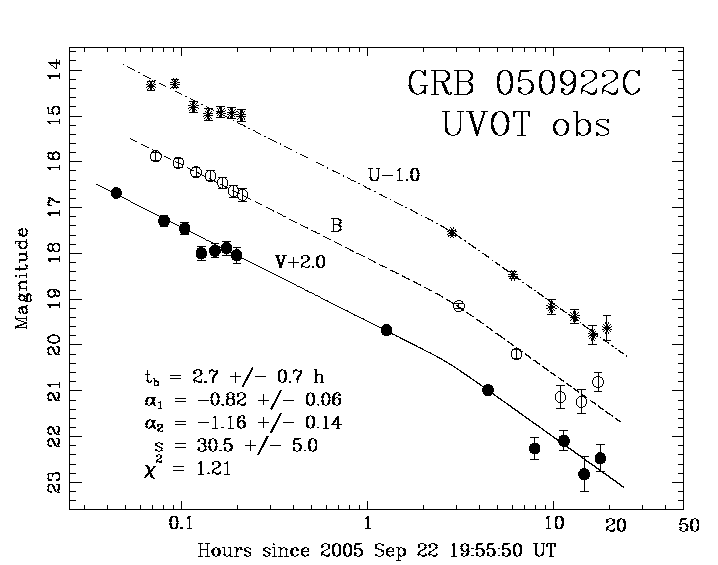
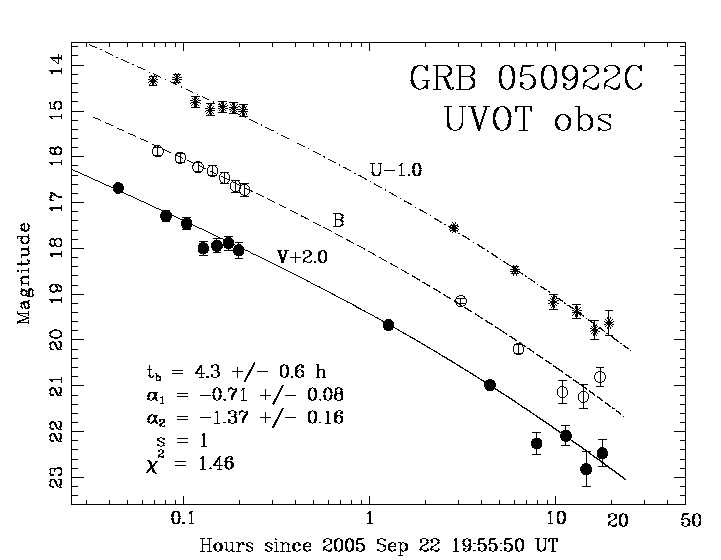
- astro-ph/0609450 from 15 Sep 2006
Jakobsson et al: HI column densities of z > 2 Swift gamma-ray bursts
Context: Before the launch of the Swift satellite, the majority of the gamma-ray burst (GRB) afterglows for which Ly-alpha was redshifted into the observable spectrum showed evidence for a damped Ly-alpha absorber. This small sample indicated that GRBs explode either in galaxies, or regions within them, having high neutral hydrogen column densities.
Aims: To increase the spectroscopic sample of GRBs with z > 2 and hence establish the N(HI) distribution along GRB lines-of-sight.
Methods: We have obtained six z > 2 GRB afterglow spectra and fitted the Ly-alpha absorption line in each case to determine N(HI). This has been complemented with 12 other Swift N(HI) values from the literature.
Results: We show that the peak of the GRB N(HI) distribution is qualitatively consistent with a model where GRBs originate in Galactic-like molecular clouds. However, a systematic difference, in particular an excess of low column-density systems compared to the predictions, indicates that selection effects and conditions within the cloud (e.g. strong ionization) influence the observed N(HI) range. We also report the discovery of Ly-alpha emission from the GRB 060714 host, corresponding to a star-formation rate of approximately 0.8 M_Sun/year. Finally, we present accurate redshifts of the six bursts: z = 3.240 +/- 0.001 (GRB 050319), z = 2.198 +/- 0.002 (GRB 050922C), z = 3.221 +/- 0.001 (GRB 060526), z = 3.425 +/- 0.002 (GRB 060707), z = 2.711 +/- 0.001 (GRB 060714) and z = 3.686 +/- 0.002 (GRB 060906).
- 0811.0989from 6 Nov 2008
Piranomonte: Probing the complex environments of GRB host galaxies and intervening systems: high resolution spectroscopy of GRB050922C
Abstract: The aim of this paper is to investigate the environment of gamma ray bursts
(GRBs) and the interstellar matter of their host galaxies. We use to this
purpose high resolution spectroscopic observations of the afterglow of
GRB050922C, obtained with UVES/VLT 3.5 hours after the GRB event. We found
that, as for most high resolution spectra of GRBs, the spectrum of the
afterglow of GRB050922C is complex. At least seven components contribute to the
main absorption system at z=2.1992. The detection of lines of neutral elements
like MgI and the detection of fine-structure levels of the ions FeII, SiII and
CII allows us to separate components in the GRB ISM along the line of sight.
Moreover, in addition to the main system, we have analyzed the five intervening
systems between z = 2.077 and z = 1.5664 identified along the GRB line of
sight. GRB afterglow spectra are very complex, but full of information. This
can be used to disentangle the contribution of the different parts of the GRB
host galaxy and to study their properties. Our metallicity estimates agree with
the scenario of GRBs exploding in low metallicity galaxies
![]() Previous IAU Circulars
Previous IAU Circulars 







